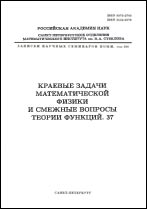|
|
Zapiski Nauchnykh Seminarov POMI, 2006, Volume 334, Pages 128–148
(Mi znsl228)
|
 |
|
 |
This article is cited in 1 scientific paper (total in 1 paper)
Filling the gap between the Gerschgorin and Brualdi theorems
L. Yu. Kolotilina
St. Petersburg Department of V. A. Steklov Institute of Mathematics, Russian Academy of Sciences
Abstract:
The paper presents new diagonal dominance type nonsingularity conditions for $n\times n$ matrices formulated in terms of circuits of length not exceeding a fixed number $r\ge 0$ and simple paths of length $r$ in the digraph of the matrix. These conditions are intermediate between the diagonal dominance conditions in terms of all paths of length $r$ and Brualdi's diagonal dominance conditions, involving all the circuits. For $r=0$, the new conditions reduce to the standard row diagonal dominance conditions $|a_{ii}|\ge\sum\limits_{j\ne i}|a_{ij}|$, $i=1,\dots,n$, whereas for $r=n$ they coincide with the Brualdi circuit conditions. Thus, they connect the classical Lévy–Desplanques theorem and the Brualdi theorem, yielding a family of sufficient nonsingularity conditions. Further, for irreducible matrices satisfying the new diagonal dominance conditions with nonstrict inequalities, the singularity/nonsingularity problem is solved. Also the new sufficient diagonal dominance conditions are extended to the so-called mixed conditions, simultaneously involving the deleted row and column sums of an arbitrary finite set of matrices diagonally conjugated to a given one, which, in the simplest nontrivial case, reduce to the old-known Ostrowski conditions $|a_{ii}|>(\sum\limits_{j\ne i}|a_{ij}|)^\alpha\;(\sum\limits_{j\ne i} |a_{ji}|)^{1-\alpha}$, $i=1,\dots,n$, $0\le\alpha\le 1$. The nonsingularity conditions obtained are used to provide new eigenvalue inclusion sets, depending on $r$, which, as $r$ varies from 0 to $n$, serve as a bridge connecting the union of Gerschgorin's disks with the Brualdi inclusion set.
Received: 28.04.2006
Citation:
L. Yu. Kolotilina, “Filling the gap between the Gerschgorin and Brualdi theorems”, Computational methods and algorithms. Part XIX, Zap. Nauchn. Sem. POMI, 334, POMI, St. Petersburg, 2006, 128–148; J. Math. Sci. (N. Y.), 141:6 (2007), 1643–1653
Linking options:
https://www.mathnet.ru/eng/znsl228 https://www.mathnet.ru/eng/znsl/v334/p128
|

| Statistics & downloads: |
| Abstract page: | 360 | | Full-text PDF : | 127 | | References: | 49 |
|




 Contact us:
Contact us: Terms of Use
Terms of Use
 Registration to the website
Registration to the website Logotypes
Logotypes








 Citation in format
Citation in format 
